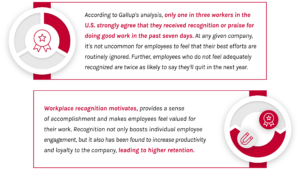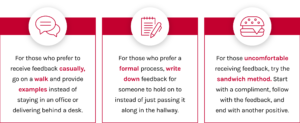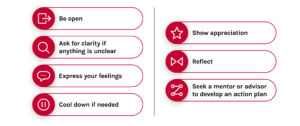Creating a feedback-centric organizational culture has a myriad of benefits, but doing so isn’t always easy. To get you started, consultants Abbie Beekman and Mary Smith discuss The Clearing’s approach to feedback, best practices for giving and receiving it, and what it looks like in practice.
How The Clearing Defines Feedback
As consultants, our teams provide and receive a lot of feedback. Feedback is so important here at The Clearing that it has its own PRIME.
But how do we define it? The Clearing defines feedback as both caring and a gift.
One of the greatest gifts you can give someone in the workplace is feedback on the impact they are having on you or others. One of the greatest gifts you can give yourself is making it easy for others to give you feedback.
Offering feedback is also a skill – both giving and receiving – and one that must be consistently worked on. Learning to provide effective feedback will make you a more effective leader. Graciously accepting feedback will do the same. Feedback isn’t synonymous with “criticism.” While constructive performance feedback on areas of potential improvement is important, providing positive feedback (i.e., recognition) on a job well done is equally important.
With that in mind, let’s dive into why feedback is critical for organizational success.
Feedback: Essential for Organizational Success
We’ve established that feedback is an important part of our work at The Clearing. However, recent data from Gallup underlines why feedback matters across every workplace. Specifically, there is a simple business case for the importance of providing effective feedback: increased productivity, engagement, and retention. All things that drive organizational success.

While this Gallup data focuses on the value of recognition, in our experience finding the balance between constructive and positive feedback is the key. We often encounter leaders who fall into one of two camps: those who are very good and consistent with providing positive feedback and those who are very good and consistent at giving constructive feedback. However, the balance of the two is important because people need both to thrive.
Our experience also tells us that one of the top motivators in the workplace is a sense of progress. By providing individuals with constructive feedback, a leader can support an individual’s ability to learn and grow in the workplace. But as almost anyone will tell you, delivering constructive feedback can be uncomfortable. We regularly speak with leaders who have difficulty sharing constructive feedback. It often turns out they are simply protecting themselves (i.e., avoiding discomfort), a natural human behavior, whether they realize it or not. Unfortunately, this comes at the expense of what is best for the other person. Fortunately, recognizing the need to become comfortable delivering constructive feedback is a win-win-win. Your team members become more effective, your organization benefits, and you evolve as a leader.
Another benefit of implementing a feedback-focused culture is the sense of psychological safety it creates. Just imagine the amount of emotional energy team members spend wondering how they’re doing without regular feedback. Let’s contrast that with the benefits of an organizational culture where regular feedback is encouraged and provided.
Best Practices: Creating a Feedback-Centric Approach in Your Organization
As we shared earlier, feedback – giving and receiving – is a skill that must be developed. The same is true for creating a feedback-centric organizational culture. Below are tips from The Clearing’s workplace culture experts on how to get started.
- Learn people’s feedback styles. Before delivering feedback, confirm the way team members want to receive it. Not everyone responds to the same feedback style, so tailoring your delivery will help ensure effectiveness. For example, do they prefer casual, direct, public, private, sandwich, written, etc.? Here are examples of how that may take shape.

Be careful with the sandwich method – you can smell a bad sandwich. Ensure that when you are delivering positive and constructive feedback in this format, both are genuine and not just being given to fit a template.
- Focus on quantity and quality. Provide feedback often and in the format that is needed for that specific person or situation. We recommend setting calendar reminders to send out regular recognition or acknowledgments.
- Be intentional, time aware, and involve the right people. Plan your feedback in advance and choose the fewest, most important things for someone to focus on. Find ways to integrate feedback into regular meetings and previously scheduled occurrences; this also helps to keep feedback going on a consistent basis. Ensure that feedback is going to the right individuals – should it be delivered one-on-one or should it go to the entire team? Finally, feedback isn’t just top-down: leaders must encourage their teams to provide them feedback and ensure team members are providing regular feedback to each other.
- Giving feedback. Giving good feedback requires practice. To ensure it is well received, think about the “Five Rights” when planning feedback conversations and consider the following questions before you deliver: Are the right topics being focused on, good or bad? Should this feedback be given in the moment or should it wait until things cool down or the project concludes? Are you the right person to deliver the feedback or should it come from someone else? Should this be done in a formal setting or somewhere more casual? Are you delivering feedback because you are upset or because it is in service of the person’s growth and development?

- Receiving feedback. Receiving feedback can be as tough as giving it. Here are the tips we provide to people across all levels to ensure they receive feedback with an open mind.

If your organization is ready to implement a feedback-focused culture – or simply wants to refine an already established one – our team of workplace leaders is ready to help you achieve your goals. Reach out whenever you’re ready – we look forward to discussing your challenges and opportunities.
